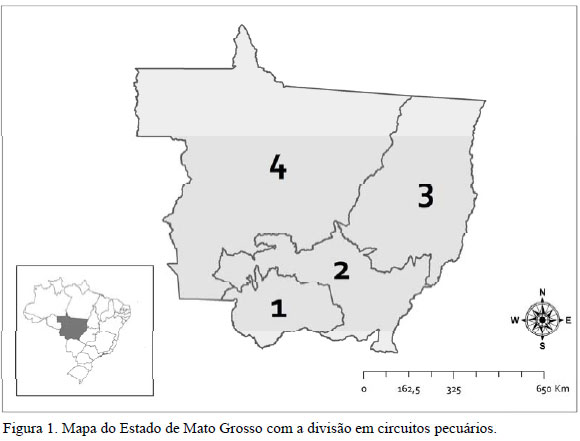A study to characterize bovine brucellosis in the State of Mato Grosso was carried out in 2003 in order to support the implementation of the National Program for the Control and Eradication of Bovine Brucellosis. The State was divided into four productive regions, and 13,684 bovines from 1,152 herds were sampled. The serum samples were screened for antibodies to Brucella spp. by the Rose-Bengal test (RBT) and all RBT-positive sera were re-tested by the 2-mercaptoethanol test (2-ME), and again by RBT for confirmation. The prevalence of infected herds and animals in the State of Mato Grosso were 41.2% [38.0-44.4%] and 10.2% [7.4-13.1%], respectively. In the productive regions, the prevalence of infected herds were 36.9% [29.2-45.2%], 27.2% [22.8-32.1%], 40.4% [38.8-46.2%], and 50.3% [44.5-56.1%], respectively; and the prevalence of infected animals were 7.9% [3.0-12.9%], 4.1% [2.8-5.4%], 8.1% [5.2-11.1%], and 15.3% [9.2-21.3%], respectively, for regions 1, 2, 3, and 4. The risk factors (odds ratio, OR) associated with the presence of the infection in the State were: beef cattle farming (OR=1.8 [1.2-2.5]), mixed (beef and dairy) cattle farming (OR=1.8 [1.2-2.7]), farms with 11 to 50 females (OR=4.8 [1.1-20.8]), farms with more than 51 females (OR=6.8 [1.6-29.0]), and occurrence of abortion (OR=1.7 [1.3-2.2]). Given that brucellosis is homogeneously distributed in the State, uniform sanitary measures might be adopted. As a homogeneous additional measure for the State, the intensification of female vaccination is suggested.
cattle; brucellosis; prevalence; risk factors; Mato Grosso; Brazil

 Epidemiologic situation of bovine brucellosis in the State of Mato Grosso, Brazil
Epidemiologic situation of bovine brucellosis in the State of Mato Grosso, Brazil







